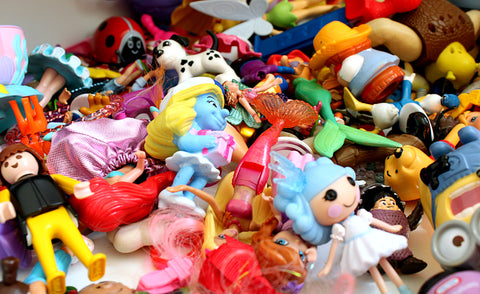How do you recycle toys?
As creators of eco-friendly toys, it’s a question we get asked a lot – how do you recycle toys?
As most of us know and agree, donating, gifting or selling toys to others is the best option. But for those toys that are broken or have missing pieces, or are just too well-worn to pass on, what’s the most environmentally friendly way to dispose of them?
Unfortunately, the answer isn’t great.

Can you recycle toys in kerbside recycling?
Unfortunately, in general, no they can’t.
Why?
The tricky thing about toys is that they’re generally made from a mix of materials, for example:
- blended plastics
- a mix of wood and plastic
- plastic with extra parts like batteries, magnets and bolts.
The mix of materials means the toys can’t be sorted by the machines at recycling facilities, and they end up being sent to landfill. Even 100% wooden toys generally can’t be recycled because of the paints and varnishes they’re decorated with.
There are exceptions to this and it’s worth checking with your local council before throwing out any toys. In particular, the Victorian Government says they can accept some plastic toys in kerbside recycling – check this link for more information. But I think this will only apply to toys with no additional parts, so things like 100% plastic building blocks or LEGO.
Don’t despair!
There are a few options…
Check if there’s a recycling stamp on your plastic toys. There are some plastic toys (like ours!) that have been manufactured out of specific materials so that they can be recycled. They’ll have a recycling stamp on them, like the one below for HDPE, which is what our toys are made from. If you can’t find the information on the toy itself, check the packaging. If your toys have a recycling stamp on them, check with your local council for how they should be recycled.

Care for toys so they can be re-used. I know, it’s not always easy (I get it, I have 3 boys!), but keeping toys in their best condition possible means they can be donated or sold and then re-used by many children over many years. Toys are generally extremely durable, so if they’re cared for, they should have a long life.
Take a look at this program from Terracycle. This is probably the best option available right now for recycling toys – you can order one of their boxes, and you fill it with old toys which they will then recycle into things like park benches and playground equipment. There are some limitations for what they can accept, but it's still a good initiative for toys that can't be donated, passed on, or can't be recycled in your kerbside recycling.
Beware of greenwashing
In a frustrating development, we've started seeing toys with packaging stating they're recyclable, when in fact they're most-certainly not recyclable. For example, we've seen a toy that is made from bioplastics with packaging stating it's recyclable. This is absolutely NOT correct. Bioplastics cannot be recycled in your kerbside recycling in Australia (yet) - they will simply end up in landfill. Programs like the one run by Terracycle (linked above) may be able to accept them, but we strongly recommend contacting them first to confirm this.
What about Happy Planet Toys?
Our toys can go into kerbside recycled bins! And as they’re made from 100% recycled milk bottles (as opposed to a blend of plastics), they can be recycled into other products another 9 more times. It’s all part of our mission to create toys which are as sustainable as possible.
